For some 40 years, Weston was the gold standard of exposure meters (at least in the USA). They produced the first photoelectric meter, the Model 617, in 1932. Weston meters were still prized by professionals when they quit making them in the early 1970s.
I am not an expert; but I have accumulated some information on these meters and I wanted to gather it together rather than have it spread out here there and elsewhere on my website.
A Little Background
Edward Weston (not the photographer) founded Weston Electrical Instrument in 1888, and began designing and manufacturing electrical equipment, particularly measuring devices. In 1932 they began selling the first commercially available photoelectric light meter, the Model 617, which used a selenium photovoltaic cell and a simple meter to measure the current it produced. It was a hit, and the company continued to develop and refine their exposure meters in subsequent years.
One of the nice things about Weston was that they gave model numbers to all their meters. Unfortunately, the numbering scheme is not as straightforward as one might like. In general, Weston made three series: the lower-tier 800-series were simpler and aimed at the amateur market; the upper-tier 700-series were aimed at professionals; earlier meters were the 600-series; the Japanese-made Westons were 500s, and the one-and-only Ranger was a 300-series.
These 700-series meters were named Masters. The first was simply the Master; subsequent versions got roman numerals. That's why I'm using the royal metaphor and calling this a dynasty.
The Model 650 "Senior" (1935-1939)
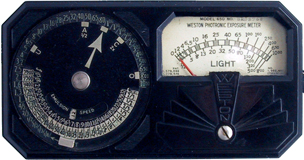
The Weston Master series, from one end to the other, all had certain characteristics in common. They include:
- Selenium photocell
- Calculator dial is not coupled with anything internally
- Calculator dial is calibrated in 1/3rd stop increments and shows the numbers for each
- Calculator dial has UACO marks
- Meter could be zeroed by the user (common in the 1930s and 40s, but by the 1960s this feature was rare)
- Meter reads directly in foot candles (except cine models and the Master V)
- Meter has two ranges (low and high) and the scale changes when a baffle over the photocell is moved in and out of place
The Model 650 "Senior" is the Charles Martel of the line, as far as I'm concerned. Of the criteria above, the only thing the Senior lacks is the dual range and the rear baffle. And while the later Masters read up to 1,600 foot candles, this one only goes to 1,000. I think that's close enough.
Two major features of this meter make it obvious that it was the model the Master was built on:
- It has the UACO markings on the calculator dial. This was a special Weston feature that many professionals adored. The U mark was 4 stops below the main pointer mark; the O was four stops above it. These are the typical boundaries of general-purpose B&W film and are useful for calculating placement and fall of gray tones. You can do the same thing mentally in your head, but having the markings directly on the dial was a nice feature. A and C did something similar for color: A was one stop below, C was one stop above, which is consistent with the narrow latitude of color films of the day (e.g. Kodachrome). C could also be considered the typical reflectance of caucasian skin.
- It was designed to be held and used horizontally and at eye-level. This is important because most meters by every other maker, including other Westons, were meant to be held vertically and at chest-level.
Because of the layout of the Senior, holding it horizontally at eye-level was pretty obvious. Not so much with the Masters.
The Master - Models 715 and 720 (1939-1945)
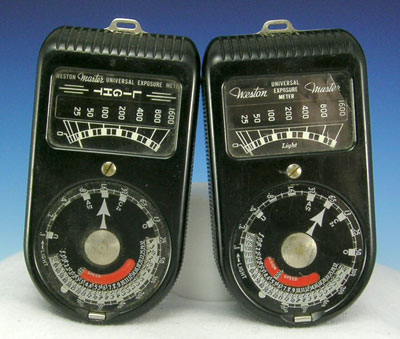
The first to bear the Master name were two models: the 715 was the "Universal" and was meant for still or cine; the 720 had a different scale and a calculator dial optimized for movie cameras.
The picture here shows two Model 715s. They're virtually identical except for the meter face. The one on the left is a little earlier and the word "Light" is printed horizontally. The one on the left has the word printed normally and moved it below the scale.
Both of these meters appear "upright," but they're both meant to be held horizontally and at eye level just like the Senior above. If you hold the Master horizontally, the number scale reads properly and "Light" on the left-hand meter makes sense.
More evidence? Check out the instruction books and look at how the meters are held in the models' hands. From this first Master of 1939 through the Euromaster in 1972, they are shown and meant to be held horizontally. (Don't go by the advertisements. Those are marketing. Look at the owner's manuals.)
The Master introduced two major things that the Senior didn't have.
- The case is no longer an octagonal box, but a softened rectangle with a circular end around the calculator dial. That circular end fit nicely into the curve between thumb and index finger. This would continue through all the subsequent Masters, though it would be tweaked with each succeeding model.
- We get dual-scale reading. On the Universal the ranges are Low: 2 to 50, High: 25 to 1,600 foot candles. On the Cine it's Low: 0 to 16, High: 0 to 26 on a Weston logrithmic "light value" scale. The number scales were printed on a sliding metal plate that was physically connected to a baffle on the rear of the unit. The baffle fit over the photocell, so when the baffle was in place, the "high" scale showed in the meter window. When the baffle was swung away, the low scale slide into place.
Master II - Models 735 and 736 (1945 - 1955)
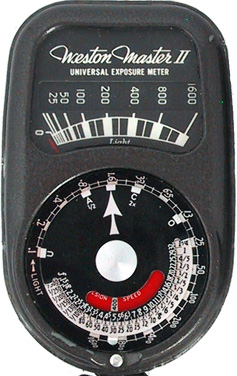
World War II disrupted everything as most companies went to war production. I'm not sure when the redesign occurred, but the Master II went into production in 1945. It was great timing: after the war people returned home with money to spend, there was a lot of pent-up demand, and the long production run for this model makes the Master II the most commonly seen.
For the most part the Master II isn't much different from the Master. They're both black, the rear photocell is the same size, the meter faces are almost identical, and the calculator dials look (to me anyway) interchangable. Functional changes are small: the exposure-index locking lever on the calculator dial became a button on the Master II, and the meter zeroing screw was moved from the front of the unit to the rear.
But the big difference is the case. It's only about ¼-inch shorter than the original Master and about the same width, but it's about 1/3rd the thickness, so it feels much smaller in the hand than its predecessor, and a little better balanced.
The standard leather case was also improved. The original came in a simple pocket-book style case and you had to pull the meter completely out to use it. The new case was a leather strap that went around the circumference of the meter case, and the front and back panels could be swung out of the way to use the meter. Thus you could use the meter and keep the case handy. This case would be found on subsequent models.
Master III - Models 737 and S217.3 (1956 - 1959)
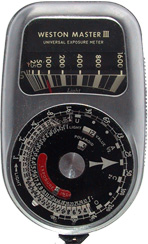
The Master III had big shoes to fill. Weston advertised it as "ruggedized" but I haven't yet seen it inside to see what the differences are. Cosmetically the differences are few. The cases appear to be identical: the size and shape are the same, as is the weight and the balance. The US version had chrome plating. The meter window was actually the same size as the Master II, but looks larger because the meter name at the top is a bit smaller.
The big difference (if you can call it that) is on the calculator dial. The E.I. lock is gone so you have to be careful not to change it accidentally. The numerator on the shutter speed ring has been removed so the numbers are a little larger. But mainly there are two windows on the dial: one for the EV, and another for Polaroid values. Polaroid made both cameras and film and tightly held their rights, so they could come up with their own exposure schemes and make it stick.
I'm not sure what was "wrong" with this unit, but it had a very short production run. Possibly Weston felt the need to update the look of the Master II to keep up with the competition, but didn't yet have a big new meter ready to go.
One big historical note, though: up through now the Weston empire was a bit like the Romans: the West was in New Jersey and they made Masters for the US market. The East was in England and the meters were made by Sangamo/Weston, a partially-owned partner of Weston. Sangamo/Weston made Masters (and possibly others) for the European market, probably to avoid trade tarrifs. Both versions were functionally identical but had a few cosmetic differences, usually the meter face (US models were typcially white lettering on black, whereas UK models were often black on white). They also had different model numbers.
Master IV - Model 745 (1960 - 1962)
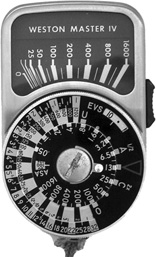
About this time Weston was purchased by a company called Daystrom, and they likely decided that having two seperate production lines was inefficient. They shut the American line down and subsequently imported the English models. They did however continue the American model designations.
This is the first real redesign since the original Master II fifteen-years earlier. The case was two piece, black on the rear and chrome on the front. It's about 1/4-inch shorter and maybe 1/8" slimmer, but retains the same height and weight. The calculator dial is a littlle larger and extends out to the edge of the case, whereas the earlier Masters had the dial sunk within the case.
There are several other major differences here. The rear cell and baffle are slightly different and the accessory Invercone (for incident light metering) had to be changed. On the side, this meter introduced a needle lock in the form of a slide switch. A spring-loaded bar normally holds the needle in place. The slide switch presses a button which lifts the bar and allows the needle to swing freely.
The biggest difference is right up front: the calculator dial got a major makeover. A little button rotates the center dial to set the E.I., which is calibrated for ASA. EV has been retained but the Polaroid system has been dropped. The whole dial has been redesigned, the numbers are larger and easier to read. Full stops (on the outermost ring) are black on white, intermediate stops (still in 1/3rd steps) are white on black. Shutter speeds are the same but reversed, calibrated around 1/60th. Fractions are black and white, full-seconds are white and red. It's my favorite calculator dial of the bunch.
This is another unit with a very short production run, for reasons I don't understand. Regardless, the next and final member of the dynasty took its place.
Master V - Model 748 (1963 - 1972)
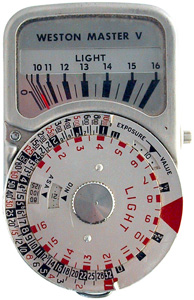
On many other products this would be considered a minor tweaking, but for Weston Masters it was huge.
Among the changes: the black (non-chromed) case is now gray. The pointer lock slide-switch became an intermittent button switch, probably because people were leaving the meter lock off with the slider. Now the pointer only swings free when the button is pressed, though it can be given a half-turn and locked.
Even though the meter is still designed to be held along its edge with the index finger resting on the meter lock button (if you're right-handed), the meter scale numbers are finally rotated so that the meter is normally read in an upright position. They do this by dropping the light-level scale and going with the log "light value" scale, similar to what they were using on their earlier cine models.
But again, the biggest change is in the calculator dial itself. First, the E.I. lock is back, this time at about the 10 o'clock position on the meter case, and a DIN rating window has been added.
More importantly, the dial face is no longer black, it's bare metal with the information printed in black, or white with a black background, or in red. 1/3rd stop increments are retained. Personally I find it harder to read than the Master IV dial, but others may disagree.
This was the last of the dynasty, as far as I'm concerned. To continue the royal lineage metaphor, I think the Euro-Masters are the Rudolph Rassendylls—look-alike cousins to the prisoner of Newark.
So What the Hell Happened?
It's hard to say, since Weston is another one of those companies that's not well publicly documented. One account I read suggested that Daystrom, Weston's owner, had big things planned for the company; but they were in turn acquired by Schlumberger, which didn't see a compelling business case for continuing in the consumer photo market.
The other thing was that the market for meters changed. In Weston's heyday hand-held meters were a standard accessory. But by the 1960s, cameras—even the low-end models—typically came with meters integrated into them. Even though the prevailing wisdom was to keep a hand-held meter as a backup or sanity check to the camera meter, the market for hand-helds shrunk considerably. Add to this the growing dominance of Japanese meters in all levels of performance, and Weston found it increasingly difficult to compete.
It probably should have been obvious with the Master IV that something was up. Weston's subsequent meters were all branded imports, either from its sister Sangamo factory in England or from Sekonic in Japan. Other American companies were having similar problems. Norwood's Director and Super Director both went Japanese. Argus bought its meters from East Germany. General Electric bailed out entirely.
Master 6 - Model 560 (1972 - 1974)
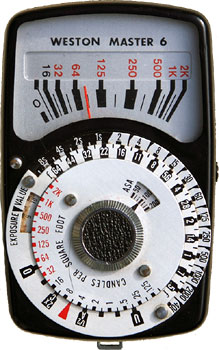
It's hard to place this relationship of this unit with the others. Weston branded a series of Japanese-built meters in the 1970s. Sekonic made a huge number of meters of all kinds, from high-end professional stuff to super-simple point-it-and-read-it jobs. The problem was that, at least with these late Westons, they looked cheap. The cases were plastic. The whole visual design is blah. And even though they carried over all the basic Master traits—the selenium cell, the sliding scale (and they brought back the direct reading of foot candles), the 1/3rd stop increments on the dial—it just wasn't quite there.
If you can stand the royal metaphor a little longer—if the Senior is Charles Martel, this is Louis XVI's missing dauphin. He may have royal blood, but he never sat on the throne.
Euro-Master - Model 461.6 (1973 - 1984)
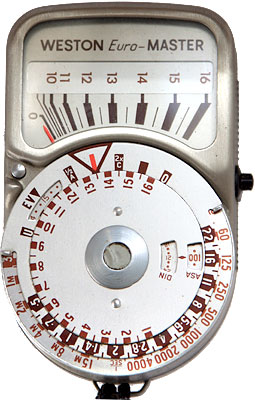 This is another tough call. Personally I would consider this the king's younger brother. This was made for the european market by Sangamo Weston, which made the UK versions of all the previous masters and the only versions of the IV and V. The differences between this and the V are slight—the main difference is the slightly re-designed calculator dial. Whereas the V was black and red, the Euro-Master went primarily with black and white-on-black. More importantly, they dropped the 1/3rd increments between stops and only printed full-stops with hash-marks for the halves.
This is another tough call. Personally I would consider this the king's younger brother. This was made for the european market by Sangamo Weston, which made the UK versions of all the previous masters and the only versions of the IV and V. The differences between this and the V are slight—the main difference is the slightly re-designed calculator dial. Whereas the V was black and red, the Euro-Master went primarily with black and white-on-black. More importantly, they dropped the 1/3rd increments between stops and only printed full-stops with hash-marks for the halves.
Euro-Master II - (1985 - 2004?)
After Sangamo-Weston shut down production in 1980, the Euro-Master continued in production in Scotland by a company called East Kilbride Instruments, but they went under in 1984. With that, the Master series (indeed all Weston-branded meters) was dead no matter how you define what was and wasn't a true Master. But in 1985, a company called Megatron acquired the rights, and appearantly the tooling, to build it and they launched the Euro-Master II. I don't own one so I'm hard pressed to tell any difference between it and the Euro-Master, other than the center dial button.
The Euro-Master II ceased production in the early 2000s, so once again this meter is no-more.
Bibliography & Notes
- Scott's Photographica Collection: Weston Model 617 (the first photoelectric meter)
- Weston Resource: a site devoted to Weston Masters
- Weston: a site devoted to Weston Masters

